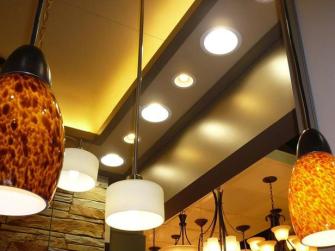Brighten Up your Living Space – 3 Ideas
 The best way to brighten a drab and dreary home is with light. However, you can turn on the light even without wattage. Here, we offer three lighting tricks—with and without light bulbs—to light up your home.
The best way to brighten a drab and dreary home is with light. However, you can turn on the light even without wattage. Here, we offer three lighting tricks—with and without light bulbs—to light up your home.
Lighten Your Décor
If your home appears dark and dismal, keep two principles in mind: Dark, matte surfaces absorb light, and light, glossy surfaces reflect light. In other words, anything dark and dull in your room will act like a black hole and suck up your room’s available light. Anything light and glossy will enhance natural light. If your walls, trim or ceiling are painted or wallpapered in a dark hue—or your floors are covered with a dark wood, stone or tile—your room will appear darker and smaller. This principle applies to the color of your décor, too. The darker the color in hard furniture, upholstery fabrics, window coverings, tablecloths and pillows, the more natural light they will absorb.
To brighten a room, re-cover or repaint any dark walls, trim or ceiling in a lighter, more reflective color and finish. You also can lighten your home by refinishing, painting or re-covering your floors. Consider a light, possibly pickled, stain for wood—or a light-colored porch paint. Replace dark linoleum, tile or stone, or you can cover the floor with a light carpet or a large area rug. Sofas, chairs, tables and pillows can be upholstered or covered with lighter fabrics and throws. Although light colors show dirt, they don’t show as much dust. Patterns, particularly those with flecks, hide dirt better than solids.
Maximize Natural Light
Your home will appear sunnier if you maximize your use of natural light. Use each room in a way that will make the most of the sun’s rays. A sunny morning room has a south- or east-facing window. A sunny afternoon room has a south- or west-facing window (a room with a south-facing window will be sunny all day). If you spend most of your day in a home office, then choose which room will take advantage of the sun without casting a glare on your computer. But to let the sun shine in, clear your windowpanes and consider living without window dressing. For decorative relief, consider mounting lightweight, glossy white exterior shutters on the inside walls around your windows.
If you need daytime privacy, use a panel of lace or sheer fabrics. If you want to have curtains or drapes, make sure they are tied back away from the window when you’re ready to let in light. You also can choose a drape with a light-colored, satiny lining and then expose the lining during the day. For a room with blocked windows, north-facing windows or no windows, get creative. Mirrors are naturally reflective: Can you bounce light off one area to another? If you like mirrors but not mirrored walls, consider creating a picture wall using mirrors instead of pictures in a variety of frames. As another alternative, consider stealing natural light from a neighboring room by breaking through part of a wall. Could you link this room to a brighter room by installing an interior window or French doors? If your room is on the top floor, could you add a skylight? To assess your home’s suitability for such structures, consider hiring a professional with the necessary expertise. This person also should be able to assist in securing the proper permits before embarking on a construction project to light up your home.
Augment Artificial Light
To maximize your use of lamps and light fixtures to light up your home, evaluate the quantity and quality of light sources in your room. Make sure bulbs are fresh and have sufficient wattage, because light bulbs lose their intensity over time. Consider replacing fixtures with ones that can accommodate a higher wattage. Use full-spectrum daylight-simulating bulbs, such as Chromalux, during the day to give the look and feel of natural light. Choose light, translucent lampshades over dark or opaque ones. Remember to pick light placement carefully. Pathway lights can make your walkway safer. Indirect reflective lights will subtly enhance natural light and won’t shine directly in your face. “Up” lights in canister fixtures hidden behind plants will let their glow bounce off your ceiling and back into the room. Recessed lighting, such as in the ceilings or cabinet, can provide subtle or romantic light. Remember, the best use of natural light, lamps and light fixtures will not only make your home seem brighter, they also will make tasks easier and put you in the right mood.
-From Realtor.com
